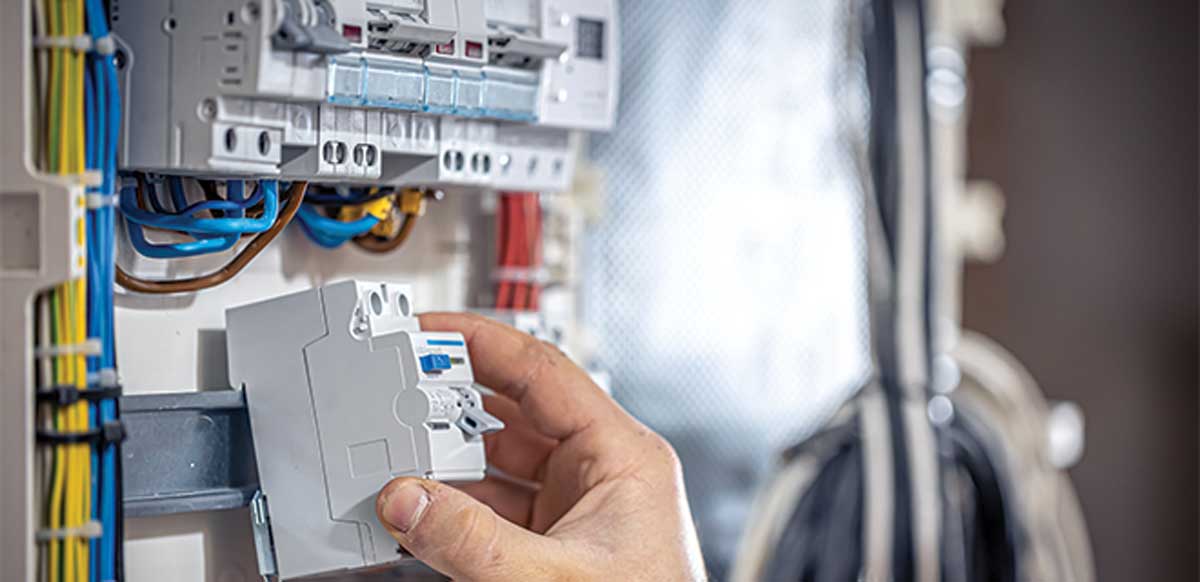Is It Dangerous if a Circuit Breaker Keeps Tripping?
When a circuit breaker keeps tripping, it is a sign of potential electrical problems like short circuits, overloaded circuits, or ground faults. This might happen because of damaged wires, faulty appliances, or old wiring that can’t handle today’s power needs.
This can harm your devices and create serious fire and shock risks. It is crucial to check and fix these issues right away to avoid dangerous outcomes. You might also need a professional to inspect your home’s electrical system to make sure everything is safe.

How Does a Circuit Breaker Work?
A circuit breaker is a key device that stops the flow of electricity when it detects an overload or short circuit. It does this to protect electrical circuits and prevent dangers like fires. Circuit breakers are found in the electrical panel and help manage how electricity is distributed safely in a building.
When a circuit breaker trips, it opens the circuit and stops the current flow. This is important to protect the wiring and connected devices from damage. The breaker can trip due to too much current, often because too many devices are using power at the same time. It uses safety features like thermal or magnetic trip units to detect problems with the current.
If a circuit breaker trips often, it may mean the circuit is overloaded. This suggests that the electrical load is more than the circuit can handle.
Knowing how circuit breakers work helps keep electrical systems safe and troubleshoot problems. Keeping the electrical load balanced and not overloading circuits helps prevent frequent tripping and maintains a safe electrical environment.
Why Do Breakers Trip?
Circuit breakers trip for several main reasons. Each of these problems can make your electrical system unsafe.
Knowing why breakers trip helps you fix issues and keep your home safe.
What Happens When a Breaker Trips?
When a circuit breaker trips, it stops the flow of electricity to prevent overheating and potential dangers. This is a key safety feature that protects your home from electrical fires and damage to your devices. Understanding what happens during a breaker trip and knowing the signs can help you respond correctly and prevent more problems.
Resetting a Tripped Breaker
Resetting a tripped breaker is important for safety.
- 1Turn off all devices and appliances connected to the circuit. This stops any power surges.
- 2Find the breaker panel. It’s usually in a utility area like the basement or garage.
- 3Look for the tripped breaker. It will be in a different position than the others.
- 4Switch the tripped breaker to ‘off’. This resets it.
- 5Wait a few seconds to let it fully reset.
- 6
Turn the breaker back to ‘on’. Make sure it clicks into place.
- 7Check the outlet or circuit to see if the power is back.
- 8Watch the breaker. If it trips again, you may have a bigger problem that needs fixing.
This method ensures you handle the breaker safely and effectively.
Key Indicators of a Bad Breaker
A bad circuit breaker shows several clear signs that it needs fixing. One big sign is if the circuit breaker trips a lot. This might mean there is too much electricity flowing or a short circuit in the wires.
Another important sign is scorch marks or discoloration around the breaker or the electrical panel. These marks show the breaker is getting too hot, which can cause bigger problems. Corroded wires in the breaker box are also a bad sign. Corrosion can weaken the electrical connections, making the breaker trip more often.
Visible damage like cracks or other deformities on the circuit breaker can also mean it is not working right. This damage could come from past electrical shocks or wear and tear over time. An unusual smell, like burning plastic, is a serious warning that the inside parts of the breaker might be damaged.
Fixing these issues quickly can stop more damage and keep your electrical system safe.
Why Is It Important to Know If Your Circuit Breaker is Bad
Understanding why it is important to know if your circuit breaker is bad helps keep your home safe and your electrical system working properly. A circuit breaker that keeps tripping may signal problems that can harm your home’s electricity and safety.
- Preventing Fires: A bad breaker can get too hot and might cause a fire.
- Protecting Devices: Things like your fridge, TV, and computer can get damaged if the electricity flow isn’t steady.
- Avoiding Surges: A faulty breaker may not handle sudden spikes in electricity, which can harm sensitive electronics.
- Ensuring Steady Power: If the breaker trips a lot, it can disrupt your daily life and make appliances less efficient.
- Saving Money on Repairs: Finding a bad breaker early can help you avoid spending a lot on big repairs or replacements later.
Replacing a Bad Breaker
Replacing a bad breaker is an important task that requires following safety steps closely. First, make sure the main power supply to the electrical box is turned off. This helps prevent any danger while you work.
The breaker that isn’t working right needs to be removed. It has three wires connected to it: the hot wire, the neutral wire, and the ground wire. Carefully remove these wires. After that, you can take the breaker out of its slot.
Next, put in the new breaker by doing the steps in reverse. Place the new breaker in the slot, making sure it fits well. Then, reconnect the hot wire, neutral wire, and ground wire to their correct terminals.
If you are not confident with your skills, it is recommended to seek help from a professional electrician.
Testing for Circuit Overload
After replacing the faulty breaker, you need to check for circuit overload. This ensures the system is not drawing too much current, which can be dangerous. Follow these steps:
Identifying Appliance Problems
Finding out what’s wrong with your appliances is important. It helps you know if an appliance is causing your circuit breaker to trip.
- Strange Sounds: If an appliance makes noises like grinding, buzzing, or clicking, it might have motor or electrical problems that could trip the breaker.
- Too Much Heat: If an appliance feels very hot, it might have an internal problem that can overload the circuit.
- Inconsistent Performance: If an appliance turns on and off by itself or works unevenly, it might be using too much power, which can stress the breaker.
- Visible Damage: Look for frayed wires, burn marks, or other signs of damage that could cause electrical problems.
- Frequent On and Off: If an appliance turns on and off more than usual, it might have a fault inside, leading to more power use and possible breaker trips.
Knowing these signs helps you or a technician fix the problems to keep your home safe and your appliances working well.
Identifying Appliance Problems
Finding out what’s wrong with your appliances is important. It helps you know if an appliance is causing your circuit breaker to trip.
- Strange Sounds: If an appliance makes noises like grinding, buzzing, or clicking, it might have motor or electrical problems that could trip the breaker.
- Too Much Heat: If an appliance feels very hot, it might have an internal problem that can overload the circuit.
- Inconsistent Performance: If an appliance turns on and off by itself or works unevenly, it might be using too much power, which can stress the breaker.
- Visible Damage: Look for frayed wires, burn marks, or other signs of damage that could cause electrical problems.
- Frequent On and Off: If an appliance turns on and off more than usual, it might have a fault inside, leading to more power use and possible breaker trips.
Knowing these signs helps you or a technician fix the problems to keep your home safe and your appliances working well.
Signs You Need an Electrician
Persistent circuit breaker trips mean you might have bigger electrical problems that need a professional.
Scorch marks on electrical outlets or light switches are a clear sign you need an electrician. These marks show overheating or sparks, which could cause electrical fires if not fixed.
Frequent tripping of ground-fault circuit interrupters (GFCIs), especially those near water sources or outdoor outlets, is another warning. This could mean a ground fault surge, which is very dangerous and needs an electrician’s help right away.
Buzzing noises, flickering lights, or a burning smell from a wall outlet or metal box are also bad signs. These symptoms often mean you have bad wiring or loose connections. Such issues can cause short circuits or electrical fires.
If you often have power outages or trouble with your electrical services, you might have a bigger problem. An electrician can find and fix these issues, making sure your home’s electrical system is safe and works well.
Ignoring these signs can be dangerous and may cause more damage to your electrical system.
Importance of Professional Home Electrical Safety Inspection
A professional home electrical safety inspection is very important for finding possible dangers and making sure your electrical system works well. Electrical systems are complicated networks where electricity has to be carefully managed to avoid dangerous situations. Certified electricians are trained to find issues that might not be obvious, especially with metal parts that can rust or wear out over time.
Tips for Breaker Longevity
To make your circuit breakers last longer, follow these easy steps. Regular checks and fixing small problems early keep them working well. Have a pro check your breakers once a year to catch issues early. This includes making sure all connections are tight, which stops overheating and breaker tripping.
Make sure each breaker handles the right amount of power. If you overload a breaker too much, it will wear out faster. Label the circuit panel clearly to spread out electrical loads evenly, so that no single circuit does too much work.
Keep the breaker panel clean and free of dust and dirt. These can mess up how the breaker works. Also, keep the panel dry to avoid shorts and rust.
Follow these steps to keep your circuit breakers in good shape.

